L. Kogan
National Radio Astronomy Observatory
Socorro, New Mexico,
USA
In the MMA memo 217 I offered A, B, C, and D configurations in the shape of concentric circles. To minimize the number of circles I used the outer circle for the next configuration as the inner circle of the previous one.
Now to minimize number of the antennas' pads I uses the same pads at the common circle for the outer and inner configuration. For D configuration the outer circle (one of three of initial configuration) is fixed now. Such a new constraint provides more symmetric main beam and allows additional saving of
the antennas' pads. The new constraint fixes some antennas' positions at the outer circles and as a result increases the value of optimized side lobes. Fortunately this increasing is very small. For optimization area at the sky in the shape of a circle with diameter 40 synthesize beams the optimized side lobes are ![]() instead of
instead of ![]() we had without constraint of the fixed antennas' positions. In the given example we saved 34 antennas' pads having 110 pads instead of 144. This saving can be even more having compromised with the level of optimized side lobes.
we had without constraint of the fixed antennas' positions. In the given example we saved 34 antennas' pads having 110 pads instead of 144. This saving can be even more having compromised with the level of optimized side lobes.
In the MMA memo 217 I offered A, B, C, and D configurations in the shape of concentric circles. To minimize the number of circles I used the outer circle for the next configuration as the inner circle of the previous one. Now to minimize number of the antennas' pads I uses the same pads at the common circle for the outer and inner configuration. For D configuration the outer circle (one of three of initial configuration) is fixed now. Such a new constraint provides more symmetric main beam and allows additional saving of the antennas' pads. The relevant enhancement of the software was carried out to implement the fixed antennas constraint. The position of the fixed antennas in the normalized form are read from the file. We start optimization with A configuration without the fixed antennas constraint. Then we use the found positions on the inner circle as a group of the fixed antennas for the outer circle of B configuration. Such an approach is repeated for B C and C D pairs.
The new constraint fixes some antennas' positions at the outer circles and as a result increases the value of optimized side lobes. Fortunately this increasing is very small. For optimization area at the sky in the shape of a circle with diameter 40 synthesize beams the optimized side lobes are ![]() instead of
instead of ![]() we had without constraint of the fixed antennas' positions. In the given example we saved 34 antennas' pads having 110 pads instead of 144. This saving can be even more having compromised with the level of optimized side lobes.
we had without constraint of the fixed antennas' positions. In the given example we saved 34 antennas' pads having 110 pads instead of 144. This saving can be even more having compromised with the level of optimized side lobes.
The found configurations (labeled by the diamonds) and the UV coverage (labeled by the dots) are shown on figures (1, 2, 3, 4 )
The two circle array configuration has been considered for A, B, and C configuration. The inner circle of the A configuration is used as the outer circle of the B configuration; the inner circle of the B configuration is used as the outer circle of the C configuration, and the inner circle of the C configuration is used as the outer circle of the D configuration. To minimize the number of the antennas' pads the inner circle positions of the A configuration is used as a fixed part of the outer circle positions of the B configuration; the inner circle of the B configuration is used as a fixed part of the outer circle of the C configuration; the inner circle of the C configuration is used as a fixed part of the outer circle of the D configuration.
The achieved minimum worst side lobe ![]() is a little bit worse than
side lobes achieved without constraint of the fixed group of the antennas' pads
(
is a little bit worse than
side lobes achieved without constraint of the fixed group of the antennas' pads
(![]() ).
Figures (5), (6), and (7) show the found optimum configurations at different scales in meters. The fixed (common for two configurations) groups of the antennas' pads are labeled by double marks.
In the given example we saved 34 antennas' pads having 110 pads instead of 144. This saving can be even more having compromised with the level of optimized side lobes.
).
Figures (5), (6), and (7) show the found optimum configurations at different scales in meters. The fixed (common for two configurations) groups of the antennas' pads are labeled by double marks.
In the given example we saved 34 antennas' pads having 110 pads instead of 144. This saving can be even more having compromised with the level of optimized side lobes.
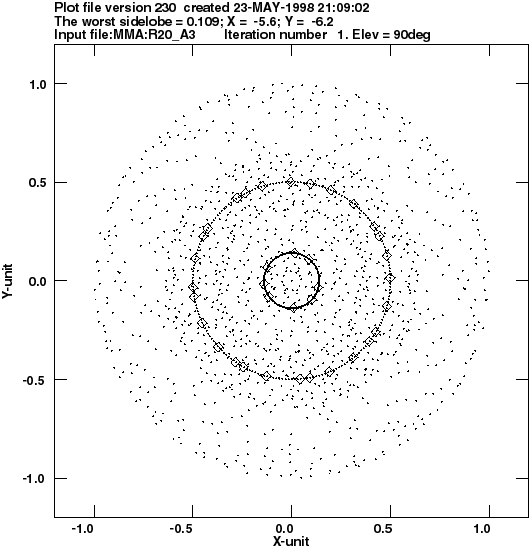
Figure 1: The optimum A configuration (diamonds) and UV coverage (dots). The outer diameter is 3000 m. The inner diameter is 840 m. Diameter of the circle of optimization at the sky is
![]() .
.
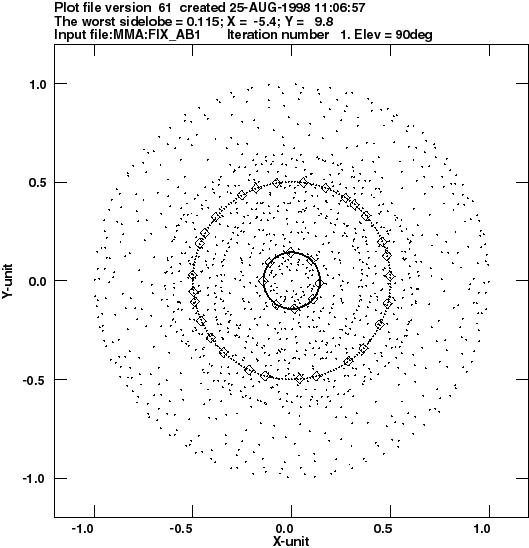
Figure 2: The optimum B configuration (diamonds) and UV coverage (dots). The outer diameter is 840 m. The inner diameter is 240 m. Diameter of the circle of optimization at the sky is
![]() .
.
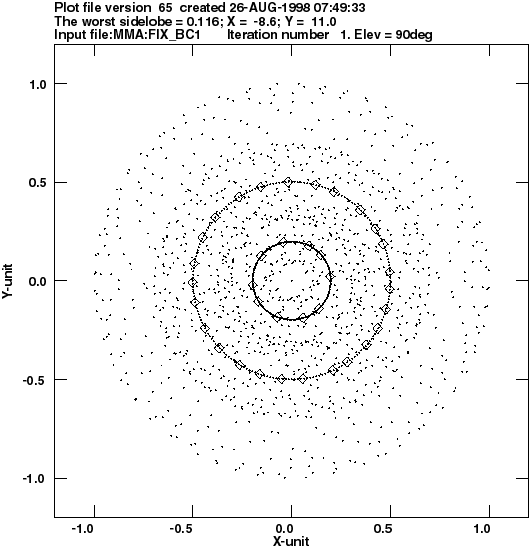
Figure 3: The optimum C configuration (diamonds) and UV coverage (dots). The outer diameter is 240 m. The inner diameter is 95 m. Diameter of the circle of optimization at the sky is
![]() .
.
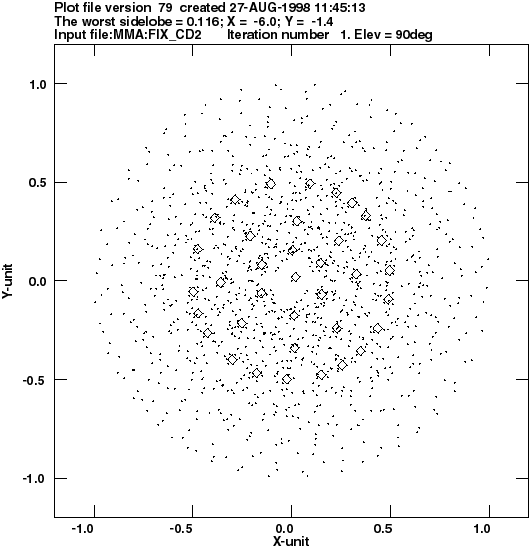
Figure 4: The optimum D configuration (diamonds) and UV coverage (dots). The outer diameter is 96 m. Diameter of the circle of optimization at the sky is
![]() . The whole sky optimization, if we include the primary beam consideration.
. The whole sky optimization, if we include the primary beam consideration.
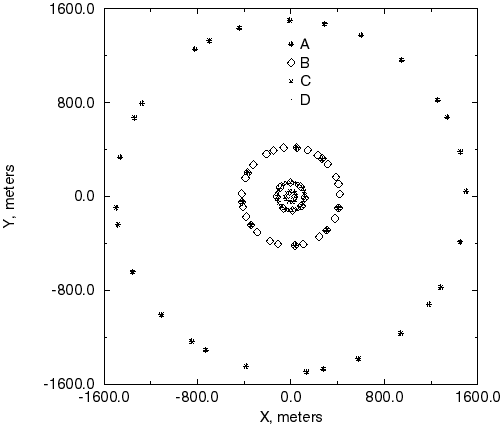
Figure 5: The optimum A, B, C, and D configurations at the actual scale in meters. The fixed (common for two configurations) groups of the antennas' pads are labeled by double marks. Diameter of the circle of optimization at the sky is ![]() .
.
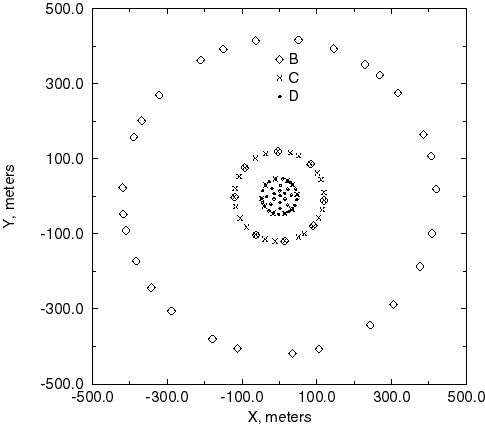
Figure 6: The optimum B, C, and D configurations at the actual scale in meters. The fixed (common for two configurations) groups of the antennas' pads are labeled by double marks. Diameter of the circle of optimization at the sky is
![]() .
.
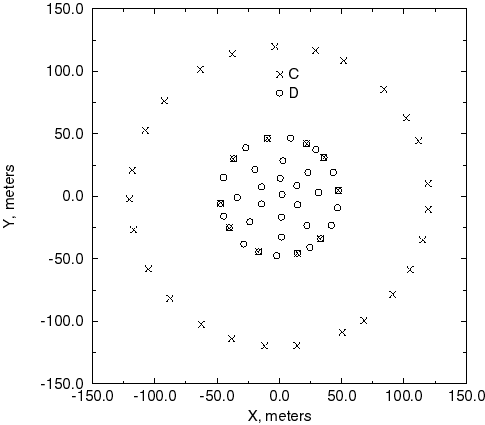
Figure 7: The optimum C, and D configurations at the actual scale in meters. The fixed (common for two configurations) groups of the antennas' pads are labeled by double marks. Diameter of the circle of optimization at the sky is
![]() .
.